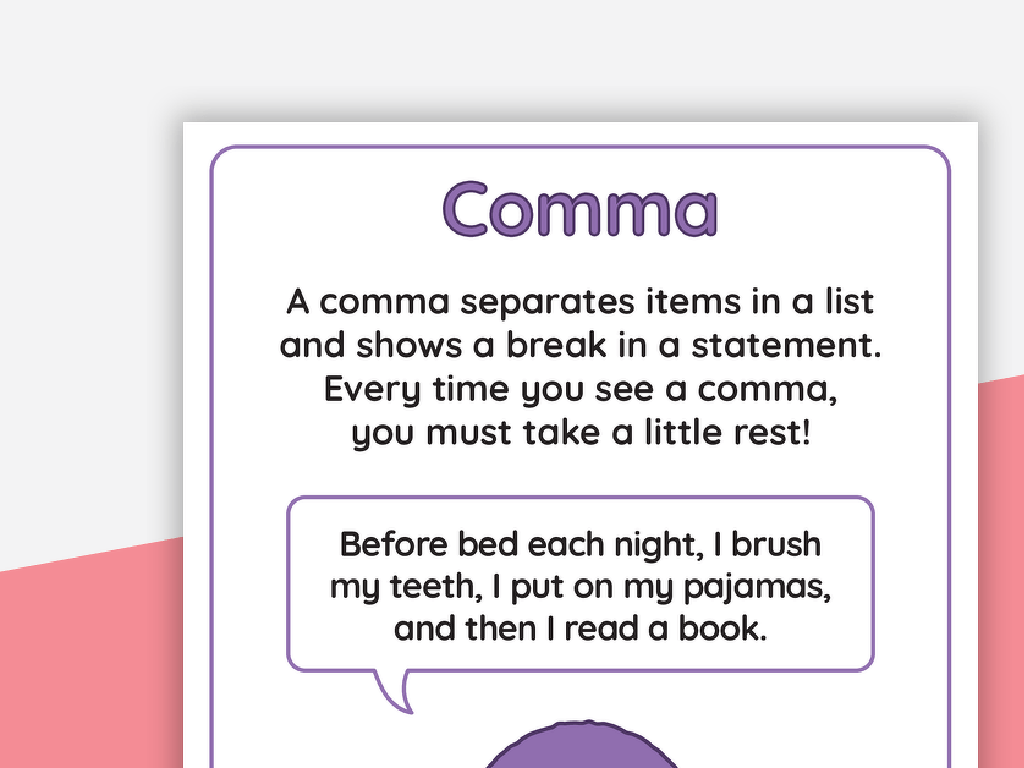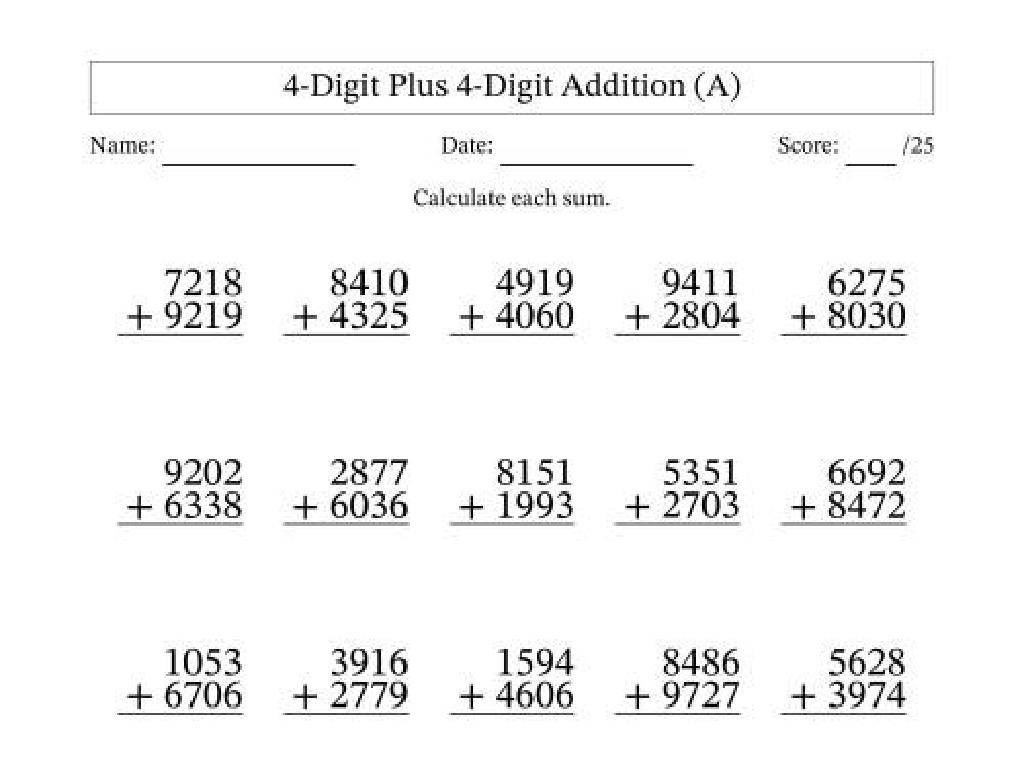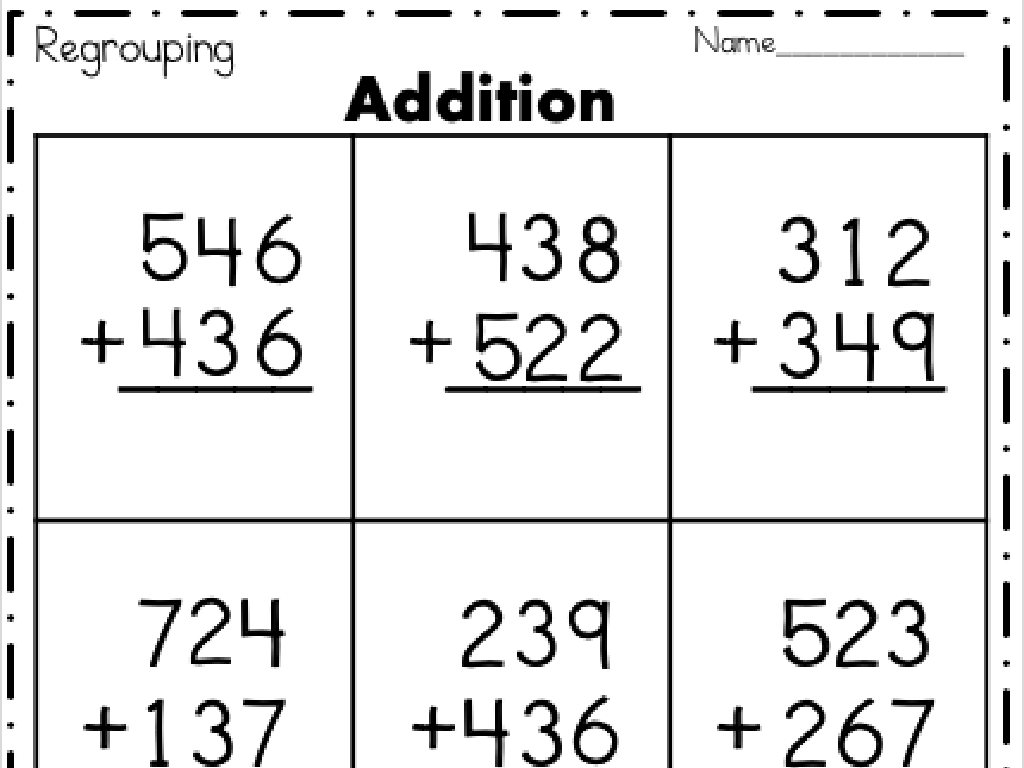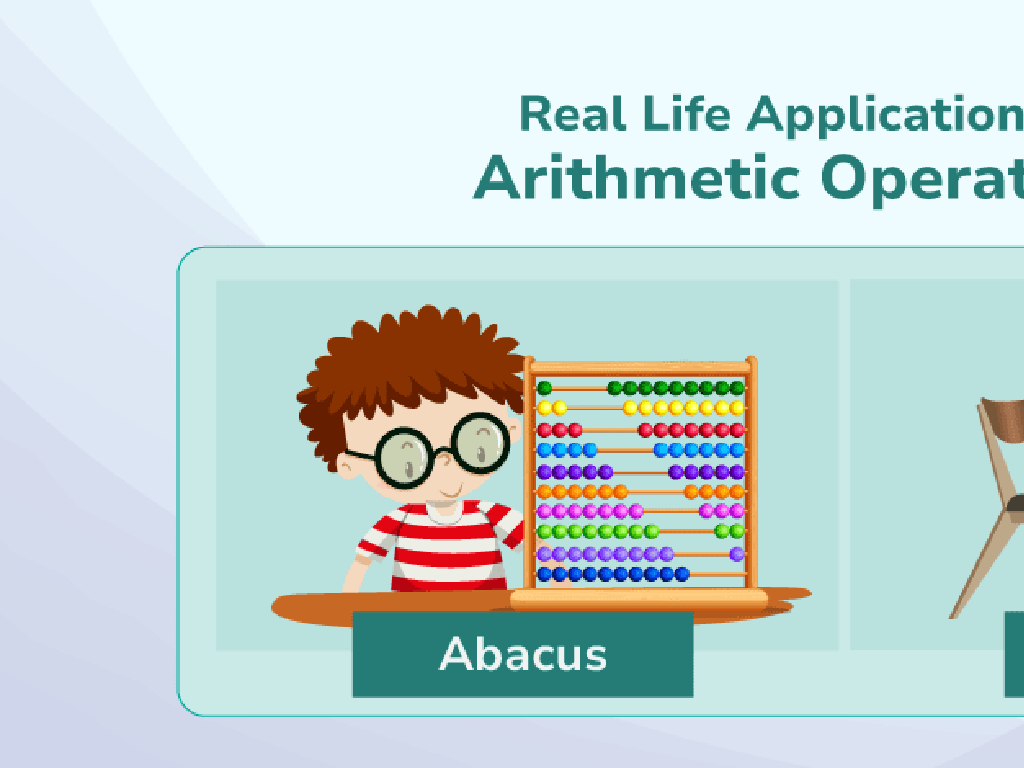Multiply 2-Digit Numbers By 2-Digit Numbers Using Area Models
Subject: Math
Grade: Fourth grade
Topic: Multiply By Two-Digit Numbers
Please LOG IN to download the presentation. Access is available to registered users only.
View More Content
Multiplying 2-Digit Numbers Using Area Models
– Explore multiplication as area
– Multiplication can be visualized as the area of a rectangle.
– Why multiplication matters
– It’s key for math in school and real-life problems.
– Steps for using area models
– Break numbers into tens and ones, then draw rectangles to represent each part.
– Practice with examples
– Let’s multiply 23 by 45 together using our new method.
|
This slide introduces students to the concept of multiplying 2-digit numbers using area models. Begin by explaining that multiplication can be thought of as finding the area of a rectangle, which makes it easier to visualize the process. Emphasize the importance of multiplication in everyday life, such as in calculating the area of rooms for flooring or understanding patterns. Walk through the steps of breaking down the numbers into tens and ones and drawing rectangles to represent each part. Finally, engage the students with hands-on practice by working through an example together, such as 23 multiplied by 45, using the area model method. Encourage students to draw their own area models and share their solutions.
Understanding Multiplication
– Reviewing multiplication basics
– A quick recap of what multiplication is
– Multiplication means repeated addition
– Instead of adding 4 three times, we can multiply 3 by 4
– Example: 3 x 4 as 4 + 4 + 4
– Visualize 3 groups of 4 items each to understand multiplication
|
Begin the lesson by reviewing the concept of multiplication, ensuring that students recall that it is a method to add the same number multiple times efficiently. Use simple examples like 3 x 4 to illustrate this point, showing that it’s the same as adding the number 4 together three times. Emphasize that multiplication is a shortcut for repeated addition, which is especially useful when dealing with larger numbers. Encourage students to visualize groups of items to help them understand the concept of multiplication. This foundational understanding will be crucial as they progress to multiplying larger, two-digit numbers using area models.
Multiplying with Area Models
– What’s an Area Model?
– A visual tool for multiplying, using length and width of rectangles.
– Area Models aid multiplication
– They break down complex problems into smaller parts.
– Components: Length & Width
– Length and width represent the digits in the numbers we multiply.
– Visualizing multiplication steps
|
Introduce the concept of an Area Model as a visual representation to help students understand multiplication of two-digit numbers. Explain how breaking down a larger multiplication problem into smaller, more manageable parts can simplify the process. Emphasize that the length and width in an area model correspond to the place values of the digits in the numbers being multiplied. This slide should set the foundation for students to visualize the multiplication process step by step, which will be further explored through examples and class activities.
Multiplying with Area Models
– Break apart numbers into tens and ones
– E.g., 23 becomes 20 (two tens) and 3 (three ones)
– Sketch the area model on grid paper
– Draw a rectangle, divide it based on place values
– Multiply the parts to find partial products
– If one side is 20 and the other is 30, area is 600
– Sum all partial products for the total
– Add the areas to find the final product
|
This slide introduces the concept of using area models to multiply two-digit numbers, a visual method that helps students understand multiplication beyond rote memorization. Begin by breaking down each number into tens and ones, which simplifies the multiplication process. Illustrate how to draw an area model on grid paper, dividing the rectangle into sections that represent the place values. Students then multiply each section to find partial products. Emphasize the importance of accurately adding these partial products to arrive at the final answer. Provide examples and encourage students to practice with different numbers to gain confidence in this method.
Multiplying with Area Models: 23 x 45
– Break down numbers into tens and ones
– 23 becomes 20 and 3, 45 becomes 40 and 5
– Draw the area model for 23 x 45
– Create a rectangle divided into 4 parts to represent each part of the multiplication
– Calculate each section of the model
– Multiply each part: 20×40, 20×5, 3×40, 3×5
– Add the sections for the total
– Sum of 800, 100, 120, and 15 gives the final answer
|
This slide introduces students to the concept of using area models to multiply two-digit numbers. Start by breaking down the numbers 23 and 45 into tens and ones. Then, guide students to draw a rectangle divided into four parts, each representing a part of the multiplication (20×40, 20×5, 3×40, 3×5). Students will calculate the area of each section, which represents the partial products of the multiplication. Finally, they will add these sections together to find the total product. Encourage students to practice this method with different numbers to build their understanding and confidence.
Practice Time: Area Models
– Let’s multiply: 34 x 56
– We’ll solve 34 x 56 as a class using an area model.
– Pair up: Try 27 x 63 together
– Find a partner and work on multiplying 27 by 63 using an area model.
– Draw your area models
– Use graph paper to sketch the area model for your multiplication.
– Present models to the class
|
This slide is designed for a hands-on practice session on multiplying two-digit numbers using area models. Start by solving 34 x 56 together with the class, step by step, demonstrating how to set up the area model on the board. Then, have the students pair up and work on 27 x 63, encouraging them to discuss each step as they draw their area models on graph paper. After they’ve completed their work, ask pairs to share their models with the class, explaining their process and how they arrived at their answers. This will help reinforce their understanding and allow them to learn from each other’s methods. Provide guidance and support as needed, and ensure that each student is engaged and participating in the activity.
Common Mistakes in Multiplication
– Remember to add all products
– Ensure every part of the area model is added together
– Keep place values in order
– Tens and ones should be in separate columns
– Align numbers correctly
– Stack numbers neatly, one under the other, before adding
|
This slide aims to highlight frequent errors students make when multiplying two-digit numbers using area models. Emphasize the importance of adding all the smaller products to get the final answer. Stress the need to keep track of place values, as mixing these up can lead to incorrect results. Demonstrate proper alignment of numbers, ensuring that each place value lines up correctly before adding. Use examples to show correct and incorrect methods, and provide practice problems that specifically address these common mistakes. Encourage students to double-check their work for these errors.
Class Activity: Area Model Art
– Create area model artwork
– Use 2-digit multiplication
– e.g., 23 x 15 for part of the picture
– Make a creative picture
– Present art and explanation
– Explain the math behind your art
|
This activity combines creativity with math, allowing students to visualize multiplication as an area model. Students will create a piece of art using different rectangles, where the length and width of each rectangle represent the two factors in a 2-digit multiplication. They should use various multiplication problems to compose their artwork. After completing their art, each student will present their picture to the class and explain the multiplication problems they used. For the teacher: Prepare grid paper and coloring materials. Guide students on how to draw area models. Suggest starting with simpler multiplications and gradually increasing complexity. Have a gallery walk at the end where students can view each other’s work. Possible variations include creating themed art, such as a garden with different sized flowers, each representing a multiplication problem.
Conclusion: Practice with Area Models
– Excellent effort in today’s lesson!
– Homework: Finish the worksheet
– Use area models for each problem
– Practice multiplying 2-digit numbers
– Remember to break down numbers into tens and ones
– Share your answers in our next class
– Discuss your strategies and any challenges faced
|
Students have worked hard to understand how to multiply 2-digit numbers using area models. For homework, they are tasked with completing a worksheet that provides additional practice to reinforce today’s lesson. Encourage them to use area models to solve each problem, breaking down the numbers into tens and ones as they have learned. Remind students that practice is key to mastering this concept. In the next class, we will have a discussion where students can share their homework, explain the strategies they used, and talk about any difficulties they encountered. This will help them learn from each other and address any lingering confusion.





